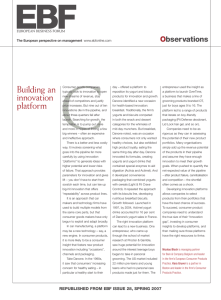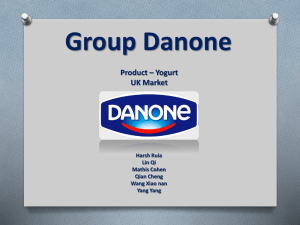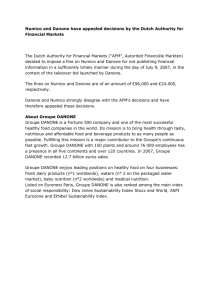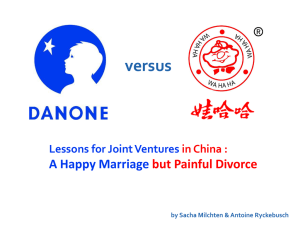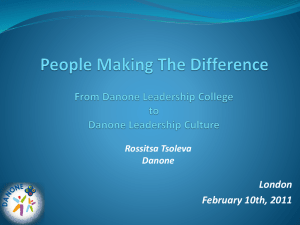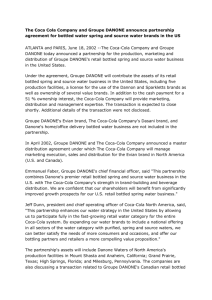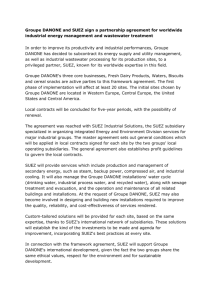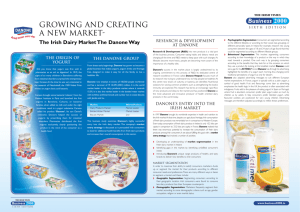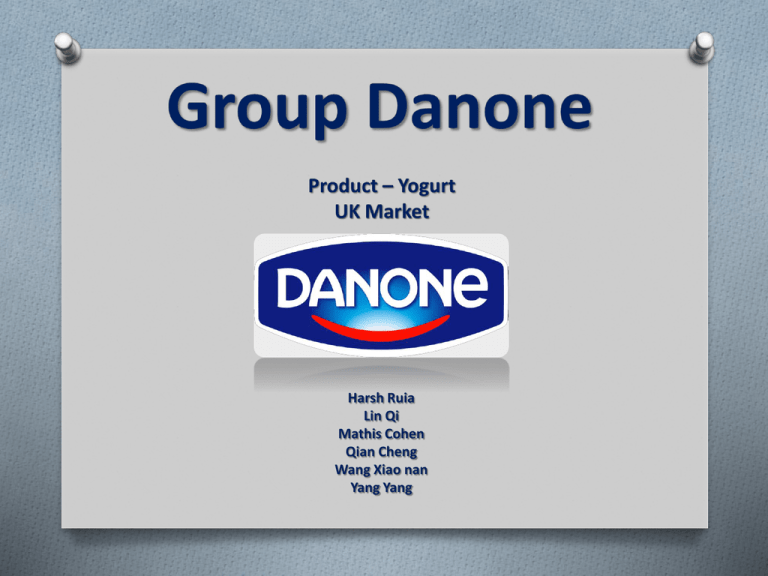
Harsh Ruia
Lin Qi
Mathis Cohen
Qian Cheng
Wang Xiao nan
Yang Yang
History of Group Danone
1919, Barcelona, Spain, Isaac Carasso,
· Named after his son Daniel.
· Manufacturing Yogurt
1929, Daniel Carasso launched Danone in Paris and business
was good.
1941, entrusted Danone France to Norbert Lafont and
Danone Spain to Luis Portabella
· Founded Dannon US
1945,rebuilding French and Spanish businesses.
· Lost interest in the US market;
· Back to BSN Gervais Danone in 1981.
1967, fusion with Gervais,
· Gervais-Danone company.
1972, Daniel Carasso and Antoine Riboud.
· Merged their two companies.
· Making Danone into a world brand
What do we have?
Fresh Dairy Product --- Yogurt
Water
Baby Nutrition
Why do we choose yogurt?
Google Trend
Yogurt
Global
United Kingdom
Yogurt seems to be paid more and more attention
Capturing Marketing Insights – the internal environment
The mostrelevant StrategicCapabilities –a resource audit of DanoneYogurt UK
Factor
Physical
Resources
Trend
Production of Yoghurts is made in larges
factories in a short amount of time due to
the raw material characteristic (milk).
Warehouses have to be high quality
standard and close to places of sales
(nature of the product
Implication
Danone owns its yoghurts factories . But all
Yoghurts are not made in the UK (Oykos are
produced in France)
Warehouses and distribution sub
contracting to two UK companies
Evaluation
+3
major
strength
Human
Resources
Three very different types of employees
: worker, administrative employee
(marketing, supply chain, finance),
scientist (R&D labs).
Danone created three graduate programs to
attire new employees. It has a learning and
development center and offers the possibility
to do sabbaticals.
+1
minor strength
Financial
Resources
Access to capital is crucial for
launch of new product and large
marketing campaign
Strong financial position with parent Danone
Group making EBITDA £2,445m
+2
significant
strength
Intangible
Resources
High brand awareness and customer
trustworthiness essential in the mass
market competition
Innovation and R&D are very important
to produce new fashionable Yoghurt
‘Danone’ has a strong brand awareness and
reputation for quality and innovative produce
Large portfolio of products not all present in
the UK
Global Danone R&D for new product
worldwide and UK lab to product adaptation
to local taste
+ 4 significant
strength
The Strategic SWOT analysis – identifying the alternatives for future success
Ext. Opportunities and risks
National campaign against obesity
Global trend to more healthy food
Emergence of new ingredients
Changes in consumer lifestyle
(healthier behaviour)
UK shows sight of recovery (0,8% from
July to Sept, strongest growth since
2010)
External Threats
Strong competition in the adult
Yoghurt market n°2 behind Muller
Price-sensitive buyer
High substitution possible in desert
and snack segments
Increasing price of raw materials
Internal Strengths
very innovative R&D labs
Excellent brand reputation for quality
and taste
Among of cash available to launch of
new products
Large portfolio of products not all
present in the UK
Internal Weaknesses
New distributor (after a massive failure
in June 2013)
Lack of flexibility (huge organisation)
Decrease in internal efficiency
Strategy choice: Product development strategy
Product development : Launch a yoghurt especialy design for kid
• Low cost of development as the product already exist in the Danone portfolio in other
•
country
•
•
Use the very strong brand image in the children
market(Danone World cup for kid, in 2013 in Wembley
London)
Small number of competitor on the segment only two
in comparison of the adult market
•
National awareness on the importance of a vary alimentation for children as a mean to
struggle against obesity
• Good understanding of the population of the importance of Calcium and vitamine D to
help the growth
• A very good way to educate people to yoghurt (parents, habit in the childhood)
Focus on the importance of calcium for kids during growth and the healthy food
7
Segmentation: How to segmenting a kid market? – Yogurt for kid 1/3
It is hard to segment kids
The percentage of children who did sport in the last 4 weeks, by age and sex, 2010/1
% boys
% girls
5 to 10 years
87.8
82.9
11 to 15 years
97
91.9
The percentage of children who need calcium and vitamin D to grow
% boys
% girls
5 to 10 years
100
100
11 to 15 years
100
100
Segmentation: How to segmenting a kid market? – Yogurt for kid 2/3
The solution : family behavior (with a focus on mother) !
Segmentation of UK family
Cluster 1: lacking time, money and knowledge
Cluster 2: lack the knowledge and parenting skills to improve their
family’s lifestyle
Cluster 1
Cluster 2
16%
14%
Cluster 3
Cluster 4
Cluster 3: affluent, overweight families who over- indulge in
unhealthy foods
Cluster 4: living healthily
Cluster 5
19%
19%
Cluster 5: strong parenting skills but need to make changes
Cluster 6: plenty of exercise but too many bad foods
15%
17%
Cluster 6
‘Differentiated’ Targeting: Focus on the most promising segments!
Targeting strategy: Differentiated Targeting
Cluster1
Cluster2
Cluster 4: living
healthily
Strong interest in
healthy diet,
active but not
focus on sport
Significant intent to
change on physical
activity and diet
rich in energydense foods
Activity levels are
high and diet drove
by taste
Accessible
through multiplatform
advertising
campaign on
importance of
yoghurt in
children healthy
diet
through multiplatform
advertising
campaign on
importance of
yoghurt for healthy
sport performance
/ store promotion
through multiplatform
advertising
campaign on
importance of
yoghurt for healthy
sport performance
/ store promotion
Measurable
through age
groups of mums
(mainly 45-64year-olds) and the
social class (AB)
through age groups
of mums
(mainly 45-64 and
17-24-year-olds)
and the social class
(C1)
through age groups
of mums
(mainly 17-24-yearolds) and the social
class (C2)
Profitable
segment stands
for 17% of
consumer market
segment stands for
19,1% of consumer
market
segment stands for
17% of consumer
market
Cluster5
Cluster6
52%
Potential consumer
Cluster 6: plenty of
exercise but too
many bad foods
Distinct:
Cluster3
Cluster4
Cluster 5: strong
parenting skills but
need to make
changes
Positioning: Developing the image of our product in consumer’s mind
Nutrition info of main competitors
Typical Values Per
100g
Tiny-Tims
Muller Little Star
Yeo Valley – Little
Yeos
Energy
405kJ/97Kcal
411kJ/98Kcal
457kJ/109Kcal
Carbohydrate(of
which sugars)
11.7g (of which
sugars 10.8g)
13g (of which sugars
12.1g)
11.9g (of which
sugars 10.4g)
13g(of which sugars
9g)
Protein
4.7g
3.7g
5.1g
5.0g
Fat(of which
saturates)
3.5g (of which
saturates 2.2g)
3.1g (of which
saturates 1.9g)
4.6g (of which
saturates 3.1g)
1g (of which
saturates 0g)
Fibre
0.1g
0.1g
Trace
0g
Sodium
0.08g
0.1g
0.1g
45mg
Calcium
140mg
108mg
200mg
20%
Yoplait Kids
Focusing on kids from 5-10
Offering nutrimental Lifestyle
Developing energetic kids
Nutrition
5-10yrs
Age
0-5yrs
Nutrition-Age Axes
Healthy
Positive
Optimistic
Nutrition
We worth it !
Price
Brand Reputation-Price Axes
Implementation Control: Assessment of the overall strategy
Continuously questions the basic direction of the strategy
Type of Control
Prime Responsibility
Purpose of Control
I. Annual-plan control
Top management; middle
management
• To examine whether the
planned results are being
achieved
Marketing controller
• To examine where the
company is making and losing
money
• To evaluate and improve the
spending
Profitability by:
• Product
• Territory
• Customer
• Segment
• Trade channel
• Order size
Line and staff management;
marketing controller
• Efficiency and impact of
marketing expenditures
Efficiency of:
• Sales force
• Advertising
• Sales promotion
• Distribution
Top management; marketing
auditor
• To examine whether the
company is pursuing its best
opportunities with respect to
markets, products, and
channels
• Marketing effectiveness
rating instrument
• Marketing audit
• Marketing excellence review
• Company ethical and social
responsibility review
I I. Profitability control
III. Efficiency control
IV. Strategic control
Approach
• Sales analysis
• Market-share analysis
• Sales-to-expense ratios
• Financial analysis
• Market-based scorecard
analysis
Appendix


